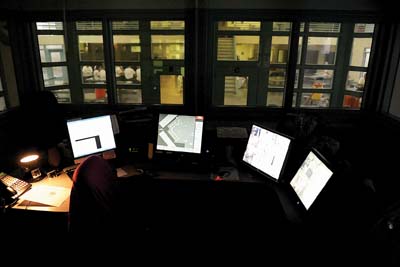
The San Benito County Jail isn’t large. Inmates cramp into
living spaces the size of about half a basketball court with five
aluminum tables, a few televisions and a small outdoor patio. Their
rooms
– if they have one – are big enough to fit a bed and toilet.
The San Benito County Jail isn’t large. Inmates cramp into living spaces the size of about half a basketball court with five aluminum tables, a few televisions and a small outdoor patio. Their rooms – if they have one – are big enough to fit a bed and toilet.
But a majority of the prison’s inmates stay in dorm-room-like halls, where their beds are scattered out in the open a few feet from one another. And there is no more space for extra beds.
With a combined six blocks – including two female pods – the jail is already meeting its maximum capacity. On Wednesday, with 115 male inmates, only 11 beds remained available and two female blocks with 12 inmates had 8 beds remaining.
But soon, due to Assembly Bill 109 signed by Gov. Jerry Brown on April 4, the jail and the community will take in nearly 100 new inmates from across the state.
To comply with a federal court order forcing the state to reduce its prison population by about 40,000 before 2013, the bill will send tens of thousands of state-prison inmates to local counties and their probation departments – eventually influencing the already crowded jails.
To help with the transfer, state officials have delayed the inmate transfer to Oct. 1, allowing local authorities to prepare a plan, county Chief Probation Officer Brent Cardall said. As of now, the local plan is to send incoming inmates to home confinement or take other probation measures.
“We will definitely beef up the enforcement of the electronic monitoring program,” he said.
Probation officers and a community review board will watch all incoming inmates.
To pay for it, the state will send the county more than $711,526 in the first year, Cardall said. The money will go to pre-trial programs (such as community service), community outreach and two additional probation officers – bringing the county’s total to 13 probation officers.
The county expects the state to continue funding for as long as the program is running, Cardall said.
“Without the funding, we can’t continue doing this,” he said.
Within the first year, the county is expected to have an increase of 100 non-serious, non-violent and non-sex offender inmates sent to the area and into probation. And all people convicted of non-serious, non-violent and non-sex offender crimes afterward will be sent to jail instead of prison, Cardall said.
“That’s the big change,” he said. “Usually, they would be sent to prison, but now we have to find beds for them here.”
Also, if newly released inmates violate probation, they will be sent to county jail or a neighboring jail, increasing those populations, Cardall said. Nationwide, around 65 percent of people on probation violate their terms. Locally, the numbers are much lower.
“That’s where we mix apples and oranges,” he said. “We do much better work than the state.”
Official plans are still developing. Sheriff Darren Thompson, Chief of Police Jeff Miller, District Attorney Candice Hooper have more meetings scheduled over the next few months.
“We’ve met once and we have plans to meet many more times,” Miller said over the phone. “It’s a collaborative effort. We are working together to provide safety for Hollister and all of San Benito County.”
Thompson said it was important for everyone to work together.
“It is really going to take a community effort,” he said.
Regardless, the influx of prisoners will affect the jail, but the jail doesn’t have enough beds for a large increase.
“I don’t know where they are going to go,” jail Sgt. Mike Kirschman said Wednesday at the jail. “As you can see, we are already almost full.”
The turquoise-lined jail splits its male inmate population into four separate pods, depending on the crime and gang affiliations. With the new bill, and the following inmates, overflow of the population will pour into four separated cells mostly used for temporary holding or those found drunk in public.
But the cells can hold just one person at a time.
“These are small with nothing really to do,” Kirschman said. “We are already almost full so some of them will have to go here.”
The cells are supposed to be temporary, he said. Despite the lack of space available, a bigger issue could be the lack of jail personnel.
After cuts to the jail staff, only four correctional officers – including the supervisor – work at the jail at one time. One sits in a control room centered between all six pods; the others roam the hallways or watch over inmates in the medical room.
“We don’t have many people, but the county just doesn’t have the money for more,” Kirschman said.
Cardall believes the county is in the right position because it won’t be overwhelmed by the increase, he said. The state money will pay for the additional cost.
“We don’t have huge numbers so it won’t overwhelm us,” he said. “The collaboration is really good. We are willing to do the right thing. We are not fighting over money or resources.”








